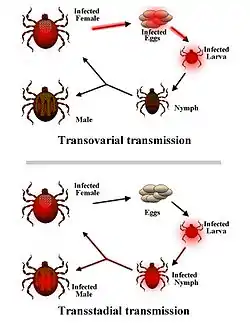Transstadial transmission
Transstadial transmission occurs when a pathogen remains with the vector from one life stage ("stadium") to the next.[1][2][3] For example, the bacteria Borrelia burgdorferi, the causative agent for Lyme disease, infects the tick vector as a larva, and the infection is maintained when it molts to a nymph and later develops as an adult.[1][2] This type of transmission is seen in other parasites like viruses or Rickettsia.[3] In addition to ticks, mites are another common vector.[3][4] Some sources consider transstadial transmission a type of horizontal transmission,[5][6] whereas other sources consider it vertical or partial vertical transmission.[7][8]

Transstadial blockage could be considered the opposite of transstadial transmission, where the parasite cannot be carried over from one life stage to the next.[4] For example, viruses that undergo transstadial blockage will have decreased infectivity in molting insects.[4]
See also
References
- Anna Rovid Spickler; James A. Roth; Jane Galyon; Jeanne Lofstedt (January 2010). Emerging and Exotic Diseases of Animals, 4th Edition. CFSPH Iowa State University. p. 22. ISBN 978-0-9745525-8-3. Retrieved 1 April 2012.
- Jesse L. Goodman; David Tappen Dennis; Daniel E. Sonenshine (2005). Tick-borne diseases of humans. ASM Press. p. 7. ISBN 978-1-55581-238-6. Retrieved 1 April 2012.
- Peter Lydyard; Michael Cole; John Holton; Will Irving; Nino Porakishvili; Pradhib Venkatesan; Kate Ward (1 January 2010). Case Studies in Infectious Disease. Garland Science. pp. 1695–6. ISBN 978-1-135-15313-7. Retrieved 3 April 2012.
- K.C. Ling (1975). Rice Virus Diseases. IRRI. p. 14. ISBN 978-971-22-0242-1. Retrieved 3 April 2012.
- Walter Werner Holland (1984). Oxford textbook of public health. Oxford University Press. p. 262. ISBN 978-0-19-261448-3. Retrieved 3 April 2012.
- Dhaar. Foundations of Community Medicine, 2/e. Elsevier India. p. 492. ISBN 978-81-312-1055-0. Retrieved 3 April 2012.
- George Gordh; Gordon Gordh; David Headrick (22 May 2003). A Dictionary of Entomology. CABI. pp. 971–. ISBN 978-0-85199-655-4. Retrieved 3 April 2012.
- Bruce F. Eldridge; John D. Edman (2004). Medical Entomology: A Textbook on Public Health and Veterinary Problems Caused by Arthropods. Springer. p. 156. ISBN 978-1-4020-1794-0. Retrieved 3 April 2012.